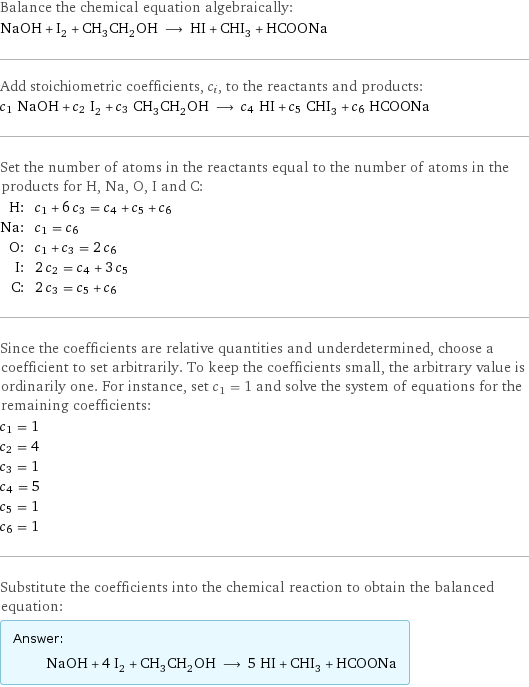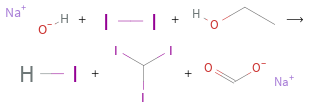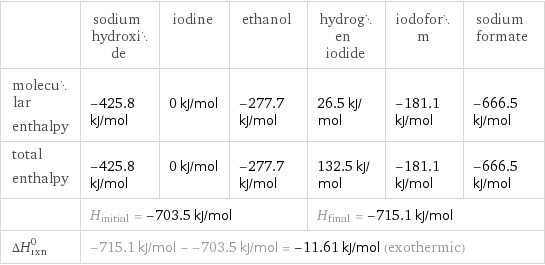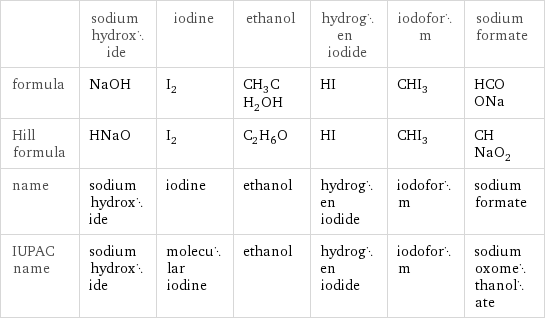Input interpretation

NaOH sodium hydroxide + I_2 iodine + CH_3CH_2OH ethanol ⟶ HI hydrogen iodide + CHI_3 iodoform + HCOONa sodium formate
Balanced equation

Balance the chemical equation algebraically: NaOH + I_2 + CH_3CH_2OH ⟶ HI + CHI_3 + HCOONa Add stoichiometric coefficients, c_i, to the reactants and products: c_1 NaOH + c_2 I_2 + c_3 CH_3CH_2OH ⟶ c_4 HI + c_5 CHI_3 + c_6 HCOONa Set the number of atoms in the reactants equal to the number of atoms in the products for H, Na, O, I and C: H: | c_1 + 6 c_3 = c_4 + c_5 + c_6 Na: | c_1 = c_6 O: | c_1 + c_3 = 2 c_6 I: | 2 c_2 = c_4 + 3 c_5 C: | 2 c_3 = c_5 + c_6 Since the coefficients are relative quantities and underdetermined, choose a coefficient to set arbitrarily. To keep the coefficients small, the arbitrary value is ordinarily one. For instance, set c_1 = 1 and solve the system of equations for the remaining coefficients: c_1 = 1 c_2 = 4 c_3 = 1 c_4 = 5 c_5 = 1 c_6 = 1 Substitute the coefficients into the chemical reaction to obtain the balanced equation: Answer: | | NaOH + 4 I_2 + CH_3CH_2OH ⟶ 5 HI + CHI_3 + HCOONa
Structures

+ + ⟶ + +
Names

sodium hydroxide + iodine + ethanol ⟶ hydrogen iodide + iodoform + sodium formate
Reaction thermodynamics
Enthalpy

| sodium hydroxide | iodine | ethanol | hydrogen iodide | iodoform | sodium formate molecular enthalpy | -425.8 kJ/mol | 0 kJ/mol | -277.7 kJ/mol | 26.5 kJ/mol | -181.1 kJ/mol | -666.5 kJ/mol total enthalpy | -425.8 kJ/mol | 0 kJ/mol | -277.7 kJ/mol | 132.5 kJ/mol | -181.1 kJ/mol | -666.5 kJ/mol | H_initial = -703.5 kJ/mol | | | H_final = -715.1 kJ/mol | | ΔH_rxn^0 | -715.1 kJ/mol - -703.5 kJ/mol = -11.61 kJ/mol (exothermic) | | | | |
Equilibrium constant
![Construct the equilibrium constant, K, expression for: NaOH + I_2 + CH_3CH_2OH ⟶ HI + CHI_3 + HCOONa Plan: • Balance the chemical equation. • Determine the stoichiometric numbers. • Assemble the activity expression for each chemical species. • Use the activity expressions to build the equilibrium constant expression. Write the balanced chemical equation: NaOH + 4 I_2 + CH_3CH_2OH ⟶ 5 HI + CHI_3 + HCOONa Assign stoichiometric numbers, ν_i, using the stoichiometric coefficients, c_i, from the balanced chemical equation in the following manner: ν_i = -c_i for reactants and ν_i = c_i for products: chemical species | c_i | ν_i NaOH | 1 | -1 I_2 | 4 | -4 CH_3CH_2OH | 1 | -1 HI | 5 | 5 CHI_3 | 1 | 1 HCOONa | 1 | 1 Assemble the activity expressions accounting for the state of matter and ν_i: chemical species | c_i | ν_i | activity expression NaOH | 1 | -1 | ([NaOH])^(-1) I_2 | 4 | -4 | ([I2])^(-4) CH_3CH_2OH | 1 | -1 | ([CH3CH2OH])^(-1) HI | 5 | 5 | ([HI])^5 CHI_3 | 1 | 1 | [CHI3] HCOONa | 1 | 1 | [HCOONa] The equilibrium constant symbol in the concentration basis is: K_c Mulitply the activity expressions to arrive at the K_c expression: Answer: | | K_c = ([NaOH])^(-1) ([I2])^(-4) ([CH3CH2OH])^(-1) ([HI])^5 [CHI3] [HCOONa] = (([HI])^5 [CHI3] [HCOONa])/([NaOH] ([I2])^4 [CH3CH2OH])](../image_source/53883f08794ac8e982ef1fc4bd38b97c.png)
Construct the equilibrium constant, K, expression for: NaOH + I_2 + CH_3CH_2OH ⟶ HI + CHI_3 + HCOONa Plan: • Balance the chemical equation. • Determine the stoichiometric numbers. • Assemble the activity expression for each chemical species. • Use the activity expressions to build the equilibrium constant expression. Write the balanced chemical equation: NaOH + 4 I_2 + CH_3CH_2OH ⟶ 5 HI + CHI_3 + HCOONa Assign stoichiometric numbers, ν_i, using the stoichiometric coefficients, c_i, from the balanced chemical equation in the following manner: ν_i = -c_i for reactants and ν_i = c_i for products: chemical species | c_i | ν_i NaOH | 1 | -1 I_2 | 4 | -4 CH_3CH_2OH | 1 | -1 HI | 5 | 5 CHI_3 | 1 | 1 HCOONa | 1 | 1 Assemble the activity expressions accounting for the state of matter and ν_i: chemical species | c_i | ν_i | activity expression NaOH | 1 | -1 | ([NaOH])^(-1) I_2 | 4 | -4 | ([I2])^(-4) CH_3CH_2OH | 1 | -1 | ([CH3CH2OH])^(-1) HI | 5 | 5 | ([HI])^5 CHI_3 | 1 | 1 | [CHI3] HCOONa | 1 | 1 | [HCOONa] The equilibrium constant symbol in the concentration basis is: K_c Mulitply the activity expressions to arrive at the K_c expression: Answer: | | K_c = ([NaOH])^(-1) ([I2])^(-4) ([CH3CH2OH])^(-1) ([HI])^5 [CHI3] [HCOONa] = (([HI])^5 [CHI3] [HCOONa])/([NaOH] ([I2])^4 [CH3CH2OH])
Rate of reaction
![Construct the rate of reaction expression for: NaOH + I_2 + CH_3CH_2OH ⟶ HI + CHI_3 + HCOONa Plan: • Balance the chemical equation. • Determine the stoichiometric numbers. • Assemble the rate term for each chemical species. • Write the rate of reaction expression. Write the balanced chemical equation: NaOH + 4 I_2 + CH_3CH_2OH ⟶ 5 HI + CHI_3 + HCOONa Assign stoichiometric numbers, ν_i, using the stoichiometric coefficients, c_i, from the balanced chemical equation in the following manner: ν_i = -c_i for reactants and ν_i = c_i for products: chemical species | c_i | ν_i NaOH | 1 | -1 I_2 | 4 | -4 CH_3CH_2OH | 1 | -1 HI | 5 | 5 CHI_3 | 1 | 1 HCOONa | 1 | 1 The rate term for each chemical species, B_i, is 1/ν_i(Δ[B_i])/(Δt) where [B_i] is the amount concentration and t is time: chemical species | c_i | ν_i | rate term NaOH | 1 | -1 | -(Δ[NaOH])/(Δt) I_2 | 4 | -4 | -1/4 (Δ[I2])/(Δt) CH_3CH_2OH | 1 | -1 | -(Δ[CH3CH2OH])/(Δt) HI | 5 | 5 | 1/5 (Δ[HI])/(Δt) CHI_3 | 1 | 1 | (Δ[CHI3])/(Δt) HCOONa | 1 | 1 | (Δ[HCOONa])/(Δt) (for infinitesimal rate of change, replace Δ with d) Set the rate terms equal to each other to arrive at the rate expression: Answer: | | rate = -(Δ[NaOH])/(Δt) = -1/4 (Δ[I2])/(Δt) = -(Δ[CH3CH2OH])/(Δt) = 1/5 (Δ[HI])/(Δt) = (Δ[CHI3])/(Δt) = (Δ[HCOONa])/(Δt) (assuming constant volume and no accumulation of intermediates or side products)](../image_source/92487a6a8b64bcb563c009337ea80751.png)
Construct the rate of reaction expression for: NaOH + I_2 + CH_3CH_2OH ⟶ HI + CHI_3 + HCOONa Plan: • Balance the chemical equation. • Determine the stoichiometric numbers. • Assemble the rate term for each chemical species. • Write the rate of reaction expression. Write the balanced chemical equation: NaOH + 4 I_2 + CH_3CH_2OH ⟶ 5 HI + CHI_3 + HCOONa Assign stoichiometric numbers, ν_i, using the stoichiometric coefficients, c_i, from the balanced chemical equation in the following manner: ν_i = -c_i for reactants and ν_i = c_i for products: chemical species | c_i | ν_i NaOH | 1 | -1 I_2 | 4 | -4 CH_3CH_2OH | 1 | -1 HI | 5 | 5 CHI_3 | 1 | 1 HCOONa | 1 | 1 The rate term for each chemical species, B_i, is 1/ν_i(Δ[B_i])/(Δt) where [B_i] is the amount concentration and t is time: chemical species | c_i | ν_i | rate term NaOH | 1 | -1 | -(Δ[NaOH])/(Δt) I_2 | 4 | -4 | -1/4 (Δ[I2])/(Δt) CH_3CH_2OH | 1 | -1 | -(Δ[CH3CH2OH])/(Δt) HI | 5 | 5 | 1/5 (Δ[HI])/(Δt) CHI_3 | 1 | 1 | (Δ[CHI3])/(Δt) HCOONa | 1 | 1 | (Δ[HCOONa])/(Δt) (for infinitesimal rate of change, replace Δ with d) Set the rate terms equal to each other to arrive at the rate expression: Answer: | | rate = -(Δ[NaOH])/(Δt) = -1/4 (Δ[I2])/(Δt) = -(Δ[CH3CH2OH])/(Δt) = 1/5 (Δ[HI])/(Δt) = (Δ[CHI3])/(Δt) = (Δ[HCOONa])/(Δt) (assuming constant volume and no accumulation of intermediates or side products)
Chemical names and formulas

| sodium hydroxide | iodine | ethanol | hydrogen iodide | iodoform | sodium formate formula | NaOH | I_2 | CH_3CH_2OH | HI | CHI_3 | HCOONa Hill formula | HNaO | I_2 | C_2H_6O | HI | CHI_3 | CHNaO_2 name | sodium hydroxide | iodine | ethanol | hydrogen iodide | iodoform | sodium formate IUPAC name | sodium hydroxide | molecular iodine | ethanol | hydrogen iodide | iodoform | sodium oxomethanolate
Substance properties

| sodium hydroxide | iodine | ethanol | hydrogen iodide | iodoform | sodium formate molar mass | 39.997 g/mol | 253.80894 g/mol | 46.07 g/mol | 127.912 g/mol | 393.732 g/mol | 68.007 g/mol phase | solid (at STP) | solid (at STP) | liquid (at STP) | gas (at STP) | solid (at STP) | solid (at STP) melting point | 323 °C | 113 °C | -114 °C | -50.76 °C | 119.5 °C | 260.5 °C boiling point | 1390 °C | 184 °C | 78 °C | -35.55 °C | 218 °C | density | 2.13 g/cm^3 | 4.94 g/cm^3 | 0.789 g/cm^3 | 0.005228 g/cm^3 (at 25 °C) | 4.008 g/cm^3 | 1.919 g/cm^3 solubility in water | soluble | | miscible | very soluble | | surface tension | 0.07435 N/m | | 0.02275 N/m | | | dynamic viscosity | 0.004 Pa s (at 350 °C) | 0.00227 Pa s (at 116 °C) | 0.001074 Pa s (at 25 °C) | 0.001321 Pa s (at -39 °C) | |
Units
